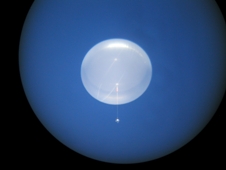Today I was invited to visit the Long Duration Balloon (LDB) project. This is actually four projects, funded by grants from NASA. University programs can apply for grant money for projects the will provide data that will complement NASA’s own research. Something in the realm of 1 in 50 applicants will actually win these grants.
Large unmanned helium balloons are an inexpensive way to bring diagnostic equipment to the edge of space. Long Duration flights can be made in Antarctica , because a persistent large low pressure vortex forms over the South Pole about this time every year. When the ideal conditions develop, the upper level winds will circle the Antarctic Continent, allowing the balloon payloads to be carried for days or weeks and still be recovered once they land on the continent. Once the best possible location is determined, the balloon can be deflated and a parachute brings the cargo to the ground, hopefully in a area where it can be safely recovered.
An ideal scenario would be that the balloon circles the continent two or three times and is dropped within visual range of the launch pad. The worst case is that it gets carried out to sea and becomes unrecoverable, or lands in a crevasse or other bad spot. Some smaller payloads can download all of their data from the sky and are relatively expendable. To lose some of the larger payloads would be very expensive in loss of equipment and data.
The LBD launching pad is constructed on the permanent ice of the Ross Ice Shelf . To get there, I climb on board “Ivan, the Terra Bus" (all of the vehicles seem to have names here). Ivan lumbers over the hill to Scott Base and then on to the ice shelf to the launch facility in the middle of the ice shelf and about 15 miles from McMurdo Station.
 |
| Ivan Awaits |
 |
Scientist and others working on the project live at McMurdo and commute to the site daily. The camp has most of the comforts, including a dining hut that serves remarkably good food, and a number of other large buildings that are towed down from their winter storage place. The launch pad is made by working the snow and ice into a firm and level platform about the size of several football fields. In the event of bad weather (which could be in the works for this weekend) workers can stay at the camp for days and even weeks if necessary. In fact I was reminded by project leaders that the last chaplain that visited here stayed for three days before the weather cleared. For larger balloons and payloads, a specially designed crane holds the payload while the balloon is launched to keep it from being dragged across the ice by the rising balloon.
 |
| Note the buildings are all on sleds |
 |
| A great lunch is served here |
 |
| This crane is built to hold a large payload while the balloon assends, not allowing the balloon the drag the payload across the ice. |
The four projects I was shown today (in my own limited recall and understanding) are these:
One of the larger payloads to be launched will be BLAST (Balloon Born Large Aperture Sub-Millimeter Telescope). This telescope looks at the dust clouds in our own galaxy and studies them to learn more about the formation and evolution of stars being formed in them.
 |
| BLAST |
 |
| Tracking Data |
CREAM (Cosmic Ray Energetics and Mass) studies the origins of cosmic rays, detecting and analyzing cosmic rays emitted from exploding super novas.
 |
| CREAM These scientists come from South Korea, by way of the University of Maryland. They are regular attenders of chapel. We are making fun of--what else?--my hight. |
This payload is designed to monitor and test NASA’s Super Pressure Balloon (SPB). The SPB is designed to expand and contract with changing temperatures, without releasing either gas or ballast in order to maintain a constant altitude. The balloon will be monitored by cameras and other instruments as it follows wind currents around the Antarctic Continent.
 |
| File picture of SPB through a telescope |
I, for some reason, didn’t take pictures of BARREL (Balloon Array for RBSP Relativistic Electron Losses). An array of balloons will be launched to study electrons that escape the radiation belt above the earth as they Earth's atmosphere. Complimentary NASA satellites will monitor the electrons within the radiation belt itself. This is the smallest of the payloads I saw. Essentially it is a Styrofoam box encasing the electron detecting instrument and some communication equipment to relay data to the ground. Attempts will be made to recover all of these payloads, but there will be no major expensed or lost data if they are not.
 |
| Keeping a close eye on the weather in hopes of launching within two or three weeks. |



Wow Really fascinating. It boggles the mind what we are able to do, especially with real international cooperation. It must be a great time for you there.
ReplyDeleteMitch